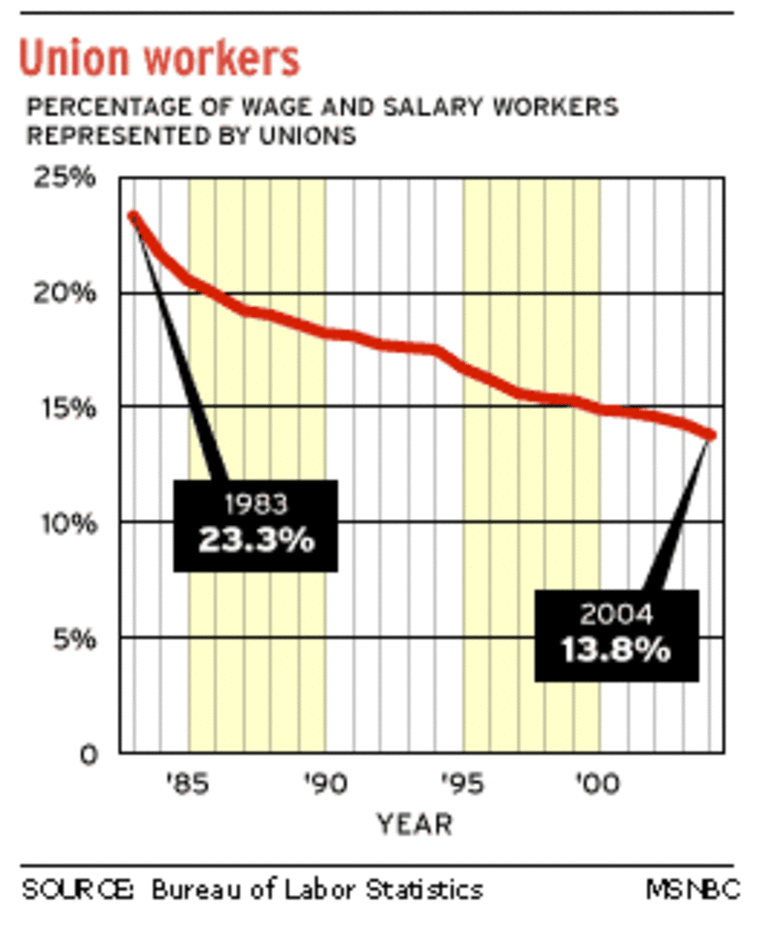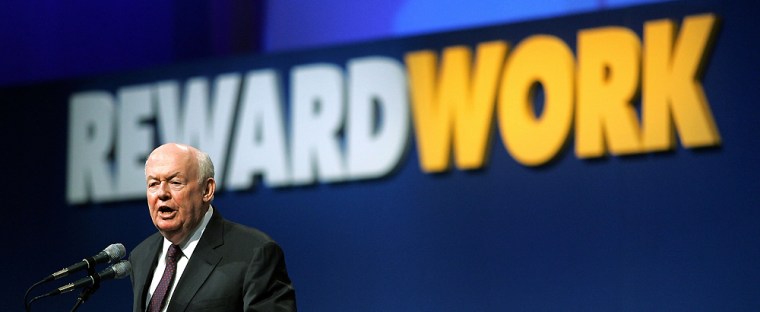The Teamsters and a major service employees union on Monday bolted from the AFL-CIO, a stinging exodus for an embattled movement struggling to stop membership losses and adjust to a rapidly changing working environment.
In a decision that AFL-CIO President John Sweeney labeled a “grievous insult” to labor’s rank-and-file, the Teamsters union and the Service Employees International Union, two major federation affiliates, said they decided to leave.
“In our view, we must have more union members in order to change the political climate that is undermining workers’ rights in this country,” said Teamsters President James P. Hoffa. “The AFL-CIO has chosen the opposite approach.”
The Teamsters joined the Service Employees International Union, the largest AFL-CIO affiliate with 1.8 million members, in bolting. The SEIU is a union that AFL-CIO President John Sweeney once headed. They said they were forming a competing labor coalition designed to reverse labor’s long decline in union membership.
This was not an easy or happy decision, said Service Employees International leader Andrew Stern, once a Sweeney protege.
“Our world has changed, our economy has changed, employers have changed,” Stern said. “But the AFL-CIO is not willing to make fundamental changes as well. By contrast, SEIU has changed.”
The joint announcement, the largest schism in labor’s ranks since 1930, came as no surprise since weeks of publicly-aired dissension within the ranks preceded it. But it hit the AFL-CIO convention like a thunder clap, nevertheless.
In advance of the dissidents’ news conference, Sweeney had chastized them for their defection at a convention also marred by boycott.
“At a time when our corporate and conservative adversaries have created the most powerful anti-worker political machine in the history of our country, a divided movement hurts the hopes of working families for a better life,” Sweeney said in his keynote address.
Many union presidents, labor experts and Democratic Party leaders fear the split will weaken the movement politically and hurt unionized workers who need a united and powerful ally against business interests and global competition.
Two other unions — United Food and Commercial Workers and UNITE HERE, a group of textile and hotel workers — joined the Teamsters and the SEIU in boycotting the convention, a step widely seen as a sign that they are also poised to leave the AFL-CIO.
The four unions, representing one-third of the AFL-CIO’s 13 million members, are part of a coalition of labor groups vowing to accomplish what the 50-year-old labor giant has failed to do: Reverse the decades-long decline in union membership.
“This split is a deep concern to Democrats everywhere,” said Democratic consultant David Axelrod of Chicago
A few blocks away from where the seven-union Change to Win Coalition held its news conference, a downsized AFL-CIO met to hear Sweeney say he was “very angry” at the breakaway leaders.
“The labor movement belongs to all of us ... and our future should not be dictated by the demands of any group or the ambitions of any individual,” Sweeney said.
“But it is also my responsibility to hold our movement together — because our power is vested in our solidarity. So I want you to know I will overcome my own anger and disappointment and do everything in my power to bring us back where we belong — and that’s together,” he said.
Labor leaders urged to stand together
Earlier, Democratic lawmakers were careful not to take sides in the fight in their convention speeches, but urged labor leaders to stand together for workers at a critical time.
Sen. Dick Durbin, D-Ill., said business interests may think the divide will make organized labor vulnerable.
“We have news for them. It’s not going to happen,” he said to cheers. “Our unity is our strength. We will stand together and fight for working families.”
After his speech, Durbin said it’s too early to tell what impact the rift will have on the Democratic Party, which relies on labor movement for money and manpower on Election Day. “I think the unions not participating in this convention are still deeply committed to working families,” he said. “I hope the separation in our union family is resolved very soon.
Sen. Barack Obama, D-Ill., made a glancing reference at the dispute, telling delegates: “There are questions of strategy and tactics of leadership and power and I can imagine many of you are anxious about labor’s future but, more importantly, you’re also anxious about your own futures.”
He urged labor leaders to adapt to the global economy, which is pressuring U.S. workers out of jobs. “There has never been a greater need for a strong labor movement to stand up for American workers,” Obama said.
“Our differences are so fundamental and so principled that at this point I don’t think there is a chance there will be a change of course,” said UFCW President Joe Hansen.

Leaders of the dissident unions demanded Sweeney’s ouster, said the AFL-CIO was beyond repair from within and demanded more money for organizing. They also are seeking power to force mergers of smaller unions and other changes they say are key to adapting to vast changes in society and the economy.
Rank-and-file members of the 52 non-boycotting AFL-CIO affiliates expressed confusion and anger over the action. “If there was ever a time we workers need to stick together, it’s today,” said Olegario Bustamante, a steelworker from Cicero, Ill.
It’s the biggest rift in organized labor since 1938, when the CIO split from the AFL. The organizations reunited in the mid-1950s.
Globalization, automation and the transition from an industrial-based economy have forced hundreds of thousands of unionized workers out of jobs, weakening labor’s role in the workplace.
When the AFL-CIO formed 50 years ago, union membership was at its zenith, with one of every three private-sector workers belonging to a labor group. Now, less than 8 percent of private-sector workers are unionized.
